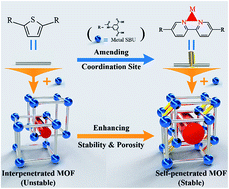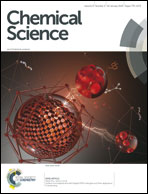Enhancing the stability and porosity of penetrated metal–organic frameworks through the insertion of coordination sites†
Abstract
Guided by the insertion of coordination sites within ligands, an interpenetrated metal–organic framework NKU-112 and a self-penetrated framework NKU-113 were obtained. The two MOFs have similar cage-based framework structures, while NKU-113 reveals enhanced porosity and stability compared with NKU-112, owing to the self-penetrated structure induced by the additional chelating bipyridine moiety in the ligand. To the best of our knowledge, this is the first study that attempts to shift the structure topology of a MOF from interpenetrated to self-penetrated while achieving a delicate modulation of the location and distances within the penetrated structure by inserting new coordination sites.

- This article is part of the themed collection: Celebrating 100 Years of Chemistry at Nankai University


 Please wait while we load your content...
Please wait while we load your content...